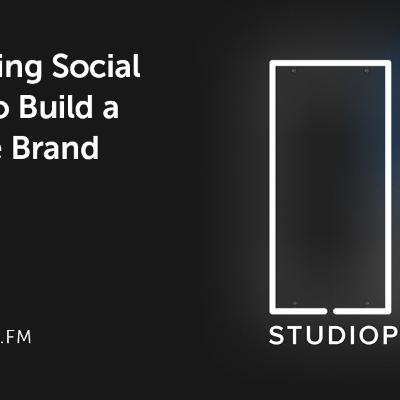How to Stay Creative in a Distracted World
Description

On this week’s episode, we’re joined by Megan Gray, a passionate — probably one of the most passionate — freelance graphic designers I know. She lives on the edge of a canyon in Orange County, California, where she runs her business, House of Grays.
Rainmaker.FM is Brought to You By
Discover why 201,344 website owners trust StudioPress, the industry standard
for premium WordPress themes and plugins.
Launch your new site today!
In this 34-minute episode Brian Gardner, Lauren Mancke, and Megan Gray discuss:
- Starting House of Grays in Orange County, CA
- Designing for the people
- Keeping focused among distraction
- Experience gained while working in a traditional agency
- The onboarding process of custom projects
- Creative outlets beyond the 9 to 5
- Following your own path instead of looking to others
- Filtering out the noise
Listen to StudioPress FM below ...
Download MP3Subscribe by RSSSubscribe in iTunes
The Show Notes
- Visit House of Grays
- House of Grays’ Work
- House of Grays’ Blog
- Follow House of Grays on Twitter
- Follow House of Grays on Instagram
The Transcript
How to Stay Creative in a Distracted World
Voiceover: Rainmaker FM.
StudioPress FM is designed to help creative entrepreneurs build the foundation of a powerful digital business. Tune in weekly as StudioPress founder Brian Gardner and VP of StudioPress Lauren Mancke share their expertise on web design, strategy, and building an online platform.
Lauren Mancke: On this week’s episode, Brian and I are joined by Megan Gray to discuss being a creative entrepreneur in a distracted and often chaotic world.
Brian Gardner: Hey everyone. Welcome to StudioPress FM. I am your host Brian Gardner. I am joined, as always, with my co-host, the vice president of StudioPress, Lauren Mancke.
Lauren Mancke: Thank you for joining us again this week as we continue with another episode in our series of talking to members of the design community.
Starting House of Grays in Orange County, CA
Brian Gardner: Today we are joined by Megan Gray who is a passionate, probably one of the most passionate, freelance graphic designers I know. She lives literally on the edge of a canyon in Orange County, California where she runs her business House of Grays. Megan, it’s a huge pleasure to have you on the show. Welcome to StudioPress FM.
Megan Gray: Thank you. I am so happy to be here.
Brian Gardner: All right. Let’s talk about Megan Gray. Taken verbatim from your website, you live on the edge of a canyon which is primarily literal in your life but I’m guessing there’s some figurative relevance here. Also, why I knew you’d be a great fit to talk about being a creative entrepreneur in a distracted world. Let’s start at the beginning and go through the early years of your life all the way back from diapers, all the way to where you are now in the OC. How did all of this happen?
Megan Gray: First, I had never thought about the metaphor of how I live on the edge of a canyon. So thank you for that. Yeah, so I guess I won’t go all the way back to diapers because that will bore everybody but I will say that I had always thought of myself as a writer and that was what I did by trade for quite a while. I worked as an editor and writer for newspapers in the DC area.
I always felt like I wanted to be a designer, have a creative profession but I felt, maybe an inferiority complex, but I felt like that was something that was always out of my reach or that was better than me because I couldn’t draw, and I thought that that was what it took to be a creative professional or be an artist. If I look back from where I sit today and I look back at all the things I was interested in or the fact that I was using Photoshop to make flyers for things in college or that I would spend hours customizing my SmugMug website for my friend’s photos with HTML and CSS.
I look back and I see that’s where I was heading but I remember at the time that felt like something cool people did and I wasn’t one of them. I just kind of chugged along doing the writing and editing thing until at some point the publisher of one of the newspapers got a temper tantrum and fired the whole design team. Overnight I had to learn InDesign and layout two papers and get them to the press on time. That’s kind of when I felt like I had been beaten into the gang. I was ready to go. From then on it was all design for me.
Then we moved to California for my husband’s job. He works at Blizzard Entertainment, which is a pretty well known video game company. That really opened up a whole new world for me in design and creativity and moving to California because of the community here and just the design style. Yeah, a lot of different cool companies to work for here locally. That’s the journey.
Designing For the People
Lauren Mancke: I can relate a little bit to the traditional arts thing because I felt the same way. I’m not a great painter or drawer so when I was looking at a major I was nervous about doing just traditional graphic arts because you have to take all those classes. I can relate to that a bit. Your website says, you have a tag line on the about page that says, “Design for the people”. What is it about people that pulls you in?
Megan Gray: I guess it’s just when somebody is doing what they love. It doesn’t matter if it’s an electrical company or jewelry making or just another creative. It’s just so compelling to me and it’s almost contagious when you work around people that are passionate about what they do. It shows up in the way that they are always there. They’re always responsive. They have ideas. They’re dedicated. They’re just excited about it. That’s irresistible to me in the sense that … I don’t care what their style is, I don’t care what their industry is, I just want to partner with them in their success and bring whatever I can to the table to help them get further faster.
That is something that took me a while to realize but I used to care more about their aesthetic style or even the industry or the budget. But, now I’m just so excited to work with people who love what they do.
Brian Gardner: Does that get you into any problems? Perfect segue into just the idea of being kind of crazy and chaotic and schedules and so forth. The fact that you like people and working with people, does that enable you to possibly take on projects you shouldn’t that might not be a good fit just because immediately you’re like, “Yes, people. I want to take it.” Or are you able to filter through and say, “I love people, but I need to take on certain types of projects so I don’t kill myself trying to take on everything?”
Megan Gray: Totally. I see what you’re saying. For me, part of what I love about those people is that they tend to be respectful of my craft, which always includes them having some sort of mindset about that good work isn’t free or cheap, and that they also have some degree of success.
I guess the short answer would be that it doesn’t really create any problems because I think when you really feel sure that you know what you love and the type of work that you want to do, it makes it really clear for me when it’s not the right work or not the right person. So I have no problem anymore passing on the projects that I know aren’t right for me.
The people who are really passionate and show up and do this work and love what they do, they tend to get projects done on time, they pay quickly or early, and it just seems to be a more pointed, focused process from start to finish for me.
Brian Gardner: Yeah, we talked to Bill Erickson a little while back just about the process of his leads and how he generates leads and the filtering process. He says the contact page, there’s sort of a questionnaire type of page, if you ask enough questions, you can siphon out the people who will admit by filling out certain things that they’re not the right fit. What is your screening process on the front end before you even get to a point where you would talk to them? Is that set up in a way where, maybe it’s by budget or something that will kind of trim out those that aren’t the right fit without even having to correspond with them?
Megan Gray: Yeah, I think somewhat differently than Bill Erickson. People know more of what they want when they look for a designer. I think developers, people are a little less educated on what makes a good developer or an expert devel























